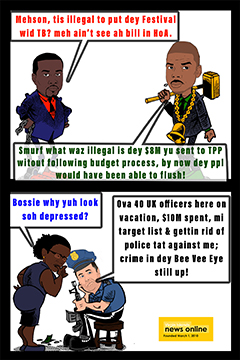Measuring Virgin Islands indebtedness -Part III
Accurate statistics, and sound economic metrics, are critical to engineering economic recovery. Accurate knowledge and the appropriate measure of a country’s economy offer policy makers information that drives good governance and social prosperity.
Now, in making any type of assertion on GDP- the total value of goods and services produced by a country - it is valid to state that growing GDP does not necessarily imply a better quality of life. A tiny number of economists are increasingly aware that good governance is more than simply generating economic growth.
Good governance is about promoting national well being; contentment, happiness, and social welfare. The idea of a ‘’happiness index’’ is the measurement of intangibles such as quality of life, and human welfare, that GDP does not measure.
A country with a large GDP metric, when compared to neighbours in its region, such as Nigeria—$400 billion— can suffer from terrible social and physical infrastructure. On the other hand a country such as Costa Rica—$50 billion—that is poorer than many neighbours in terms of natural and financial resources, possesses first world social and economic infrastructure, and a much higher quality of life metric.
Social welfare is more than the improvement in the material wealth of the society. GDP has to be linked to improving quality of life, for GDP to be a tool for improving the lives of the population. Good governance is using GDP in the most efficient, effective, and innovative way, in the pursuit of the greater quality of life of all the citizens and residents of a country.
And indebtedness, when it is private indebtedness directly impacts quality of life. Personal debt is a source of worry. Personal debt produces anxiety. It can become a great burden on individuals, families, and businesses.
A 2012 study using an international data set from Gallup found that citizens of nations with progressive tax policies, that invest in public services: education, transportation, experience greater wellbeing. Citizens of the welfare state are happier. This is because good public services touch many more people than what any privately driven system will provide.
Governments that provide for the social welfare of the most vulnerable, and the betterment of the working and middle classes, in terms of education, social care, cultural investment, healthcare, green spaces, and so on and so forth, build stronger communities and societies. This is directly opposed to supply-sided ideologically driven governments that view human beings as simple statistics: units of consumption that drive economic growth through their spending habits, and business productivity. The preceding leaves communities poor and vulnerable.
Now, lending money to transparent and democratic governments in free societies is deemed safe lending, especially when there is a healthy projected annual GDP, based on historical numbers, and a level of financial solvency that will service borrowing.
Better still, where debt to GDP ratios are backed up by accurate numbers from treasury and financial agencies. That is something that is absent in the Virgin Islands.
Post Irma, and looking into the next 20 years, the cost of recovery will come from borrowing.
The exact figure of the money required for full recovery cannot be readily determined, but if it has been estimated that total destruction from Irma is in the 3-4 billion dollar range, then it can safely be stated that the Virgin Islands will need to borrow in terms of both public borrowing- government, and private borrowing– business and household- in the region of at least 3 billion over the upcoming decade, to replace damaged infrastructure, and place the country firmly on the path to development and prosperity.
Consequently, the country’s financial managers must have accurate numbers on indebtedness in order to accurately manage the country’s finances and resources.
What is the total national debt, the total figure of all the country’s internal and external borrowings? What is the short term debt figure: loans that are to be paid in say 1-3 years? What was the government total expenditure in the past year and what were its total revenues? Compare the preceding with the past 5 years.
What are the totals of all the various types of taxes and payments into the treasury, such as payments from offshore interests, public agencies, and public utilities? Again, assessed and compared to the prior years in terms of debt to GDP?
Possessing accurate economic statistics that Joe Public can understand is a prerequisite for any type of economic recovery and social development. That is because it offers government a guiding narrative, a road map, to El Dorado.
Connect with Dickson Igwe on Facebook and Twitter














.png)
























1 Response to “Measuring Virgin Islands indebtedness -Part III”